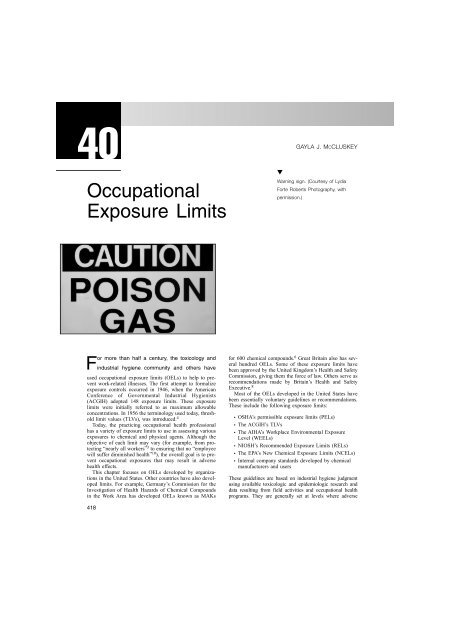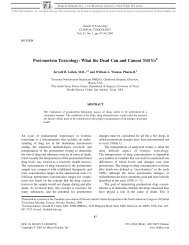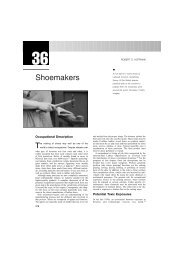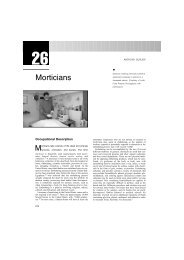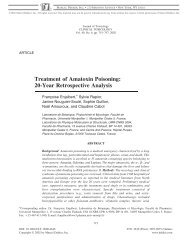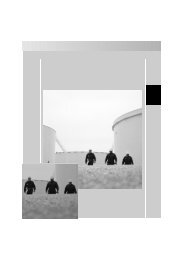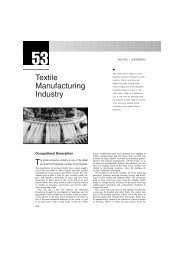Chapter 40 - Occupational Exposure Limits.pdf
Chapter 40 - Occupational Exposure Limits.pdf
Chapter 40 - Occupational Exposure Limits.pdf
You also want an ePaper? Increase the reach of your titles
YUMPU automatically turns print PDFs into web optimized ePapers that Google loves.
ENVIRONMENTAL PROTECTION AGENCYThe EPA recently began setting OELs under the authorityvested in that agency by the Toxic Substances Control Act (15USC s/s 2601). Anyone who plants to manufacture or importa new chemical substance must submit notice to the EPA. TheEPA conducts a risk assessment and, if the agency determinesthat the chemical may present an unreasonable risk of injuryvia inhalation exposure, it will set a new chemical exposurelimit (NCEL). These limits are for informational purposesonly and are not legally enforceable limits. However, chemicalmanufacturers are bound by a TSCA Section 5(e) ConsentOrder to follow the agency’s recommendations. Currently,more than 20 limits are posted on the EPA web site. 7CHEMICAL MANUFACTURERS AND USERSChemical manufacturers often set OELs for the chemicalsthey manufacture or formulate. These internal limits areusually published on the material safety data sheet document(MSDS) provided to the customer.DefinitionsThe terminology used to define various exposure limits isfairly consistent among the organizations that set OELs.Specific definitions are provided in the following discussion,although readers should refer to the referenced documentationfor the basis of each OEL.TIME-WEIGHTED AVERAGEMany exposure limits are based on time-weighted average(TWA) calculations, which apportion the measuredexposure to the time period in which the exposureoccurred. Thus, an employee could be exposed to concentrationsabove or below the exposure limit during theworkday.This practice is not intended to subject an employee toan unreasonably high level of exposure. The ACGIH hasrecognized that excursions above the exposure level shouldbe held to reasonable limits. The ACGIH suggests thatexcursions during a workday may exceed three times theTLV-TWA for no more than a total of 30 minutes, and forno more than five times the TLV-TWA, provided that theTWA-TLV is not exceeded. 3In a typical workday, an employee is often exposed toseveral different short-term average concentrations as aresult of changes in job assignment, processes, and ventilationconditions. The TWA method calculates the full-shiftaverage concentration by weighting different short-termaverage concentrations by exposure time. The TWA can becalculated using the following formula:TWA = C 1 T 1 +C 2 T 2 +C n T n8 hours<strong>Occupational</strong> <strong>Exposure</strong> <strong>Limits</strong> / <strong>40</strong> 421where:TWA = time-weighted average concentration, usuallyin parts per million or milligrams per cubic meter.C = concentration of contaminant during the incrementalexposure time.T = time, T 1, T 2, T 3....T nare the incremental exposuretimes at average concentrations C 1, C 2+ C n.Eight hours is generally used as the denominator, asmost standards are based on an 8-hour workday. 14The application of OELs to workers on work schedulessignificantly different than the 8-hour day, <strong>40</strong>-hourweek should be done only by industrial hygiene professionals.8-HOUR TWA LIMITMost exposure limits apply to the entire 8-hour workday.Using the TWA concept above, the resultant calculatedconcentration could then be compared with the variousoccupational exposure limits (OSHA’s PELs, NIOSH’sRELs, ACGIH’s TLVs, AIHA’s WEELs, EPA’s NCELs,and industry standards). The averaging time for all of theseis up to 480 minutes (8 hours) for a <strong>40</strong>-hour work week,except for the RELs, which use up to 10 hours during a<strong>40</strong>-hour week.SHORT-TERM EXPOSURE LIMITSThe ACGIH defines a short-term exposure limit (STEL) asa concentration that would not result in irritation, chronicor irreversible tissue damage, or narcosis that would impairthe worker or materially reduce work efficiency. Theselimits are set for chemicals that have recognized acuteeffects in addition to toxic effects that primarily are of achronic nature. STELS are considered to be a requirementin addition to the TWA limits.A STEL is calculated as a TWA using an averaging timeof 15 minutes. It should not be exceeded at any time duringa workday, even if the 8-hour TWA is not exceeded.<strong>Exposure</strong>s should not be longer than 15 minutes andshould not occur more than four times per day, with 60minutes between successive exposures. 2CEILINGA ceiling limit (c) indicates a concentration that should notbe exceeded during any part of a workday. According toOSHA, if instantaneous monitoring is not feasible, then theceiling shall be assessed as a 15-minute time-weightedaverage exposure that shall not be exceeded at any timeduring the working day. 12 The ACGIH indicates that thesampling time should not exceed 15 minutes, except forsubstances that may cause immediate irritation when exposuresare short. 2
422 SECTION I / <strong>Occupational</strong> ToxicologySKIN NOTATIONThis notation appears with other exposure limits andindicates that a substance may be absorbed in toxicamounts through the skin or mucous membranes. OSHA,ACGIH, AIHA, and NIOSH exposure limits include thisdesignation.SENSITIZER NOTATIONBoth the ACGIH and the AIHA note chemicals that causesensitization. For ACGIH, the designation “SEN” is usedfor these agents based on human or animal data. 3 TheAIHA uses two designations: “DSEN” indicates the potentialfor dermal sensitization resulting from the absorbedagent and ultraviolet light, and “RSEN” indicates respiratorysensitization. 5PHYSICAL AGENTSOSHA and the ACGIH set OELs for physical agents of anacoustic, electromagnetic, ergonomic, mechanical, or thermalnature. These limits differ from inhalation TLVs inthat many are based on actual industrial experience andhuman experimental studies. The limits are not single numbersand should only be applied by users who have trainingand experience in the specific measurement andevaluation techniques. 3BIOLOGICAL EXPOSURE INDICESTechnically not OELs, BEls are guidance values for assessingbiological exposure results and are set for nearly <strong>40</strong>chemicals and chemical classes by the ACGIH. These valuesrepresent the levels of determinants that are most likelyto be observed in specimens collected from healthy workerswho have been exposed to chemicals to the same extentas workers with inhalation exposure at TLV levels. Theexceptions are for chemicals with inhalation TLVs basedon protection against nonsystemic effects such as irritation.In this case the BEls are necessary, as these chemicals havethe potential for absorption via another route of entry (usuallythe skin). 3SummaryOELs are based on the concept of a dose–response relationshipbetween the chemical or physical agent and resultanthealth effects that results in the conclusion that there isa lower level of exposure where adverse health effects willnot occur. They do not afford a fine distinction betweensafe and dangerous conditions, owing to individual susceptibilityand other factors.OELs should be considered guidelines for good practice.Their application requires knowledge of the basis of thelimit and an understanding of the methods and proceduresfor monitoring exposure.EMERGENCY RESPONSE LIMITSThe following guidelines are technically not considered tobe actual OELs but are important in emergency responseplanning.NIOSH, as part of the Standards Completion Program,developed values for chemicals that represented exposurelevels that were immediately dangerous to life and health(IDLH). An IDLH levels is defined as a condition thatposes a threat of exposure to airborne contaminants whenthat exposure is likely to cause death or immediate ordelayed permanent adverse health effects, or to preventescape from such an environment. These limits are for a30-minute period. 9The AIHA issues ERPGs, which are community-basedexposure limits for use in planning for accidental chemicalreleases. They are intended to be used to assess theadequacy of preventative and response measures undertakenfor chemical releases and transportation emergencies.The ERPGs include three levels for a 1-hour periodat which progressive levels of adverse health effects areexpected. 5REFERENCES1. AFL-CIO v. OSHA, 965 F2d 962 (11th Cir 1992).2. American Conference of Governmental Industrial Hygienists: 2000Threshold Limit Values for Chemical Substances and Physical Agentsand Biological <strong>Exposure</strong> Indices. Cincinnati, Ohio, ACGIH, 2000.3. American Conference of Governmental Industrial Hygienists: 2001Threshold Limit Values for Chemical Substances and PhysicalAgents and Biological <strong>Exposure</strong> Indices. Cincinnati, Ohio, ACGIH,2001.4. American Conference of Governmental Industrial Hygienists on line:Available at http://www.acgih.org/About/History.htm/5. American Industrial Hygiene Association: The AIHA 2001Emergency Response Planning Guidelines and Workplace Environmental<strong>Exposure</strong> Level Guides Handbook. Fairfax, Va, AIHA, 2001.6. Deutsche Forschungsgemeinschaft: MAK and BAT Values 2001(Report 37). Weinheim, Germany, Commission for the Investigationof Health Hazards of Chemical Compounds in the Work Area, 2001.(Available in the United States from John Wiley, 605 Third Ave, NewYork, NY 10158-0012.)7. Environmental Protection Agency on line: Available athttp://www.epa.gov/opptintr/newchems/ncelmain.htm/8. Health and Safety Executive: <strong>Occupational</strong> <strong>Exposure</strong> <strong>Limits</strong> 2001.Sudbury, Suffolk, U.K., Health and Safety Executive Books, 2001.9. National Institute for <strong>Occupational</strong> Safety and Health (NIOSH):NIOSH Respirator Decision Logic (DHHS [NIOSH] Publication No
<strong>Occupational</strong> <strong>Exposure</strong> <strong>Limits</strong> / <strong>40</strong> 42387-108, NTIS Publication No PB-91-151183). Washington, DC,NTIS, 1987.10. <strong>Occupational</strong> Safety and Health Act, 29 USC Chap 15.11. <strong>Occupational</strong> Safety and Health Administration: 29 Code of FederalRegulations, 1910. 1000. Washington, DC, OSHA, 1971.12. <strong>Occupational</strong> Safety and Health Administration: CPL 2.445B—Changes to the Field Operations Manual (FOM). Washington, DC,OSHA, 1993.13. Olishifski JB: Fundamentals of Industrial Hygiene, 2nd ed. Chicago,National Safety Council, 1971.14. Plog BA: Fundamentals of Industrial Hygiene, 4th ed. Itasca, Ill,National Safety Council, 1996.


